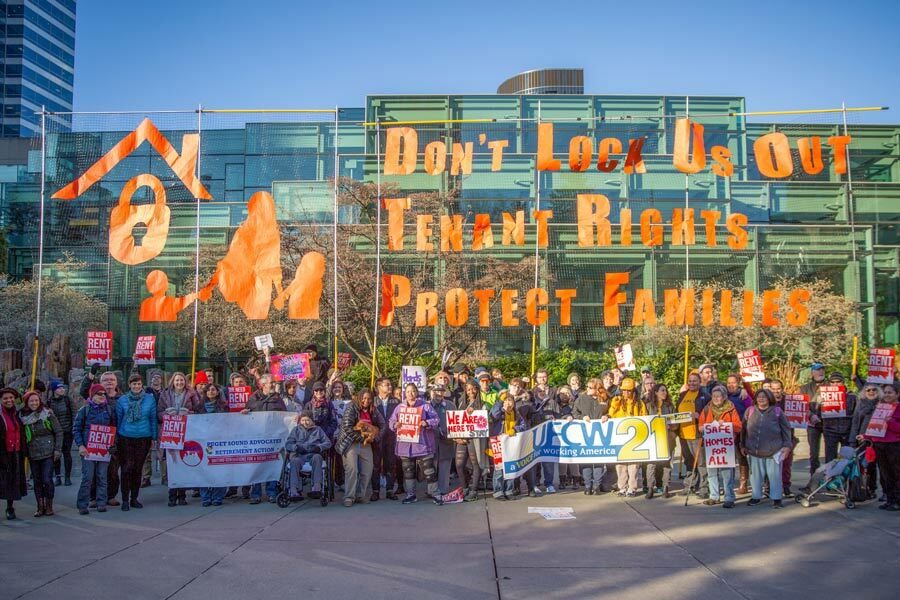Landlords, Your Lease Is Up: A New Movement for Rent Control Is Spreading Across the U.S.
Tenant activists, local unions, community organizations and socialists are leading campaigns to regulate rents and weaken the market’s grip on housing.
Rebecca Burns

Nancy Buttanda, 68, has watched in horror as her rent check eats up more and more of her fixed income. The rent on her apartment in Federal Way, Wash., has increased annually at least $100 a month for three or four years, she says, and her landlord rarely makes repairs. She now pays $1,245 a month for rent, water and trash, while living on pension, Social Security and disability payments that amount to around $3,300. A recent auto accident stuck her with $400 car payments, and after paying for Medicare, electricity and everything else, she’s often left with less than $300 each month for necessities.
Because she struggles with mobility due to multiple knee replacements, Buttanda dreads the idea of moving and doubts she’d be able to find another apartment in her price range with an elevator. She applied last year to county-subsidized affordable housing developments that cater to seniors, but was told she was over the income limit — by $80 a year.
“I feel like I’m out of options,” she says. “I’ve never been so scared in my life.” Federal standards set the threshold for “affordable housing” at 30 percent of a family’s income, a threshold that Buttanda’s rent exceeds. One in four U.S. households spends more than half of its income on rent. In 1985, the median U.S. family spent just 19 percent of its income on housing.

Nancy Buttanda is part of a revived movement for rent regulation in Washington state. (Photo by Chloe Collyer)
In the 40 years preceding the Great Recession, rents grew twice as fast as incomes. Then came the 2008 housing crash, in which more than 10 million families lost their homes to foreclosure. Less than one-third are likely to buy again, thanks to wrecked finances and credit scores. As a result, more U.S. households are renting now than at any point in at least the past 50 years. Due in large part to predatory lending, Black and Latino households were more than 70 percent more likely than white ones to lose their homes in 2012, and they’re now nearly twice as likely to be renters. Rent affordability is also worse in communities of color: Median renters in predominantly Black neighborhoods spend 44 percent of their income on rent, and renters in predominantly Latino communities spend 48 percent.
As this nationwide housing affordability crisis becomes harder to ignore, Washington state is one of several places where advocates are launching a renewed push for rent regulation, thanks in large part to activism by tenants like Buttanda. While a scattering of cities and towns in four states — California, Maryland, New Jersey and New York — and Washington, D.C., have rent control laws in place, 35 states, including Washington, prohibit or limit local governments from regulating rent hikes. But legislation introduced by Democrats in Washington in January would repeal the state’s ban, in effect since 1981. As a member of the progressive advocacy group Washington Community Action Network (WCAN), Buttanda hopes to convince a newly Democratic-controlled state legislature that curbing skyrocketing housing costs should be a top priority.
Progressive legislators in Illinois also have pending legislation that would repeal restrictions on rent control. And in California, a first-of-its-kind “national renters day of action” in September 2016 helped propel rent control to victory at the ballot box in two cities and launch new campaigns in at least seven others. While rent control remains a controversial measure among mainstream Democrats (many of whom receive hefty donations from real estate lobbies), these campaigns are attracting support from a broad swath of local unions and community organizations, as well as socialists who see rent control as the first step toward weakening the market’s grip on a basic human need.
“Rising rents aren’t an act of God; they’re an act of price gouging,” said Kshama Sawant, socialist Seattle City Council member, to a cheering crowd during a July 2015 debate with local developers.
On Dec. 5, 2017, hundreds of members of WCAN, tenants’ rights groups and local unions gathered at the annual meeting of several state real estate organizations in Seattle. The renters were there to crash the landlords’ party.
Inside the Washington State Convention Center, a series of demonstrators stood up, one by one, and interrupted the meeting to speak about rising homelessness and the dire need for affordable housing. Event staff quickly escorted the demonstrators out.
Outside, State Rep. Nicole Macri (D) announced her plans to introduce a bill to overturn the ban on rent regulation, to cheers from the crowd. “We cannot waste this opportunity,” Macri said of Democrats’ newly won control of the state house. “Up until this point, the legislature has been nibbling around the edges.” In recent years, Washington state and the city of Seattle have both passed a series of tenant protections that fall short of rent control. In 2016, for example, the city unanimously passed legislation proposed by Sawant that caps the move-in fees for a new apartment at the equivalent of one month’s rent.
But that legislation is being challenged in court by several major landlords, who charge that it violates their free speech and due process rights. Housing advocates expect a similar challenge to current efforts at rent regulation. “The landlord associations have fought any and all tenants’ rights legislation at the local and state level,” says Xochitl Maykovich, political director for WCAN. “We decided to protest their convention to make the point that we’re not going to roll over.”
The history of rent control bans also involves a backlash by real estate lobbies. A wave of militant tenant organizing won the passage of new rent control laws in four states and dozens of cities from 1972 to 1985. Spooked by these reforms, real estate interests quickly organized a powerful countermovement that pushed through a slew of so-called preemption laws, which allow states to overturn or prevent municipal-level progressive policy, beginning in the 1980s. At the center of these efforts was an old bête noire of progressives: the American Legislative Exchange Council (ALEC), which writes sample right-wing legislation. State prohibitions on minimum wage hikes and fracking bans have received recent attention, but ALEC’s little-noticed “rent control preemption act” also appears to have been quietly adopted in state after state.
Even where rent control hasn’t been banned outright, landlords have successfully chipped away at protections. In California, where 13 cities passed rent control between 1972 and 1985, the real estate lobby and sympathetic legislators launched several unsuccessful efforts to ban the measure at the state level — both through legislation and through a proposition that voters defeated 65 percent to 35 percent in 1980. A 1987 report by the California Association of Realtors claimed that the industry had spent over $14.2 million to fight rent control. Finally, in 1995, a rightward shift in state politics provided an opening for passage of the Costa-Hawkins law, which prohibits rent control on apartments built after that year and allows landlords to hike rents in older buildings once existing tenants leave.
The law also restricts the types of units covered by rent control, a major issue in areas such as Sacramento County, where the largest private landlord is the Wall Street-owned Invitation Homes. The company bought up tens of thousands of foreclosed homes nationwide in the wake of the financial crisis, and the single-family homes it now rents out are exempt from all local rent control laws in California.
Renita Barbee was forced to leave her single-family home in Los Angeles last year when Invitation Homes, which has a heavy presence in the city, hiked the rent from $2,120 a month to $3,000. After Barbee attended a protest against the company organized by a local community group, Invitation Homes informed her that the initial increase had been a “mistake” and the new rent would be just $2,320 a month. But for Barbee, at the time the only wage earner in her household after her mother’s recent death, that amount was still out of reach — nearly half her income. “If companies like Invitation Homes keep these rent increases up, we’ll all end up on the street,” she says. “We need rent control for single-family homes.”
California housing rights groups are waging a multi-pronged campaign to repeal Costa-Hawkins and allow cities like Sacramento and Los Angeles to enact stronger rent control laws. A bill to that effect was introduced in the state assembly in 2017 but was slow to attract support, even from Democrats. In January, the bill died in committee.
The Alliance of Californians for Community Empowerment (ACCE) and two other groups filed a proposed ballot initiative in October 2017 that would allow voters to repeal Costa-Hawkins. To get the referendum on the November 2018 ballot, the groups will have to gather 365,800 signatures by April 24. They kicked off a signature drive in early January.
To win, advocates will need to convince voters that rent control works.
An oft-cited 1992 poll by the American Economic Association found that 93 percent of its members agreed, “a ceiling on rents reduces the quality and quantity of housing.” That helped cement the conventional wisdom that rent control actually hurts tenants by discouraging developers from maintaining existing properties or building new ones. In 1999, Forbes named rent control (along with collective bargaining) one of the “dumbest ideas of the century,” citing this rationale.
But research examining the effect of rent control on displacement has yielded different conclusions. In 2015, the Urban Displacement Project — a collaboration between researchers at UC Berkeley, UCLA and Portland State University — looked at the average rate of displacement in hundreds of gentrifying California neighborhoods. Rent control was a common factor among those that experienced less displacement than expected, based on the rate of gentrification and other risk factors. The researchers also noted that the actual numbers on housing production belie the claim that rent control stunts construction. Between 2007 and 2013, the six cities in the Bay Area with rent control produced more housing units per capita than the cities without it.
Could rent control discourage landlords from making repairs? Amy Schur, campaign director of the ACCE, has little patience for this argument. “Landlords have an obligation to keep their properties up to code,” she says. “The state constitution even guarantees a reasonable rate of return, so landlords can petition a rent control board to raise rents in order to make repairs.”
Another argument holds that high rents are the result of constrained supply, and building more housing will naturally lower costs without government interference. But WCAN’s Maykovich doubts that the market will ever produce housing that’s affordable for senior and disabled renters like Nancy Buttanda. “I hear a lot that if we just fix supply, then everything will be magic and life will be great,” says Maykovich. “But there will always be landlords trying to gouge their tenants.”
Proponents of new, market-rate housing often suggest that, as these apartments age, they will naturally fall in price and become available to lower-income households. A 2014 study suggests that this process, known as “filtering,” occurs at an annual rate of about 1.9 percent. But in tight urban housing markets, especially in neighborhoods made to appear more desirable by luxury condo development, this process may happen much more slowly. Researchers at Berkeley’s Institute for Governmental Studies concluded that “filtering is not enough” to prevent displacement. More effective, according to the study, is building new subsidized housing.
In December 2017, more than a dozen organizations, including WCAN, convened in Washington, D.C., for a “Peoples’ Hearing on Housing,” where they outlined a slate of more far-reaching demands. In addition to controls on rent, the coalition called for new federal investment in public housing, a $200 billion “anti-displacement fund” for affordable homes in gentrifying cities, zero-interest loans for communities of color where predatory lending has historically run rampant, a $350 billion climate resilience fund to finance energy efficiency upgrades to homes, and a national tenants’ bill of rights.
In the meantime, however, Congress has been gutting funding for public and subsidized housing programs for years, a trend the Trump administration has moved to continue. Many housing advocates see rent control as a measure that’s winnable in the short term, without backing from hostile federal agencies.
“Pushing to repeal the ban on rent regulation will allow us to have a broader conversation about housing affordability throughout the country,” Maykovich says. “Ultimately, we need to be calling for increased investment in housing from all levels of government.”
Rebecca Burns is In These Times’ housing editor and an award-winning investigative reporter. Her work has appeared in Business Insider, the Chicago Reader, the Intercept, ProPublica Illinois and other outlets.









